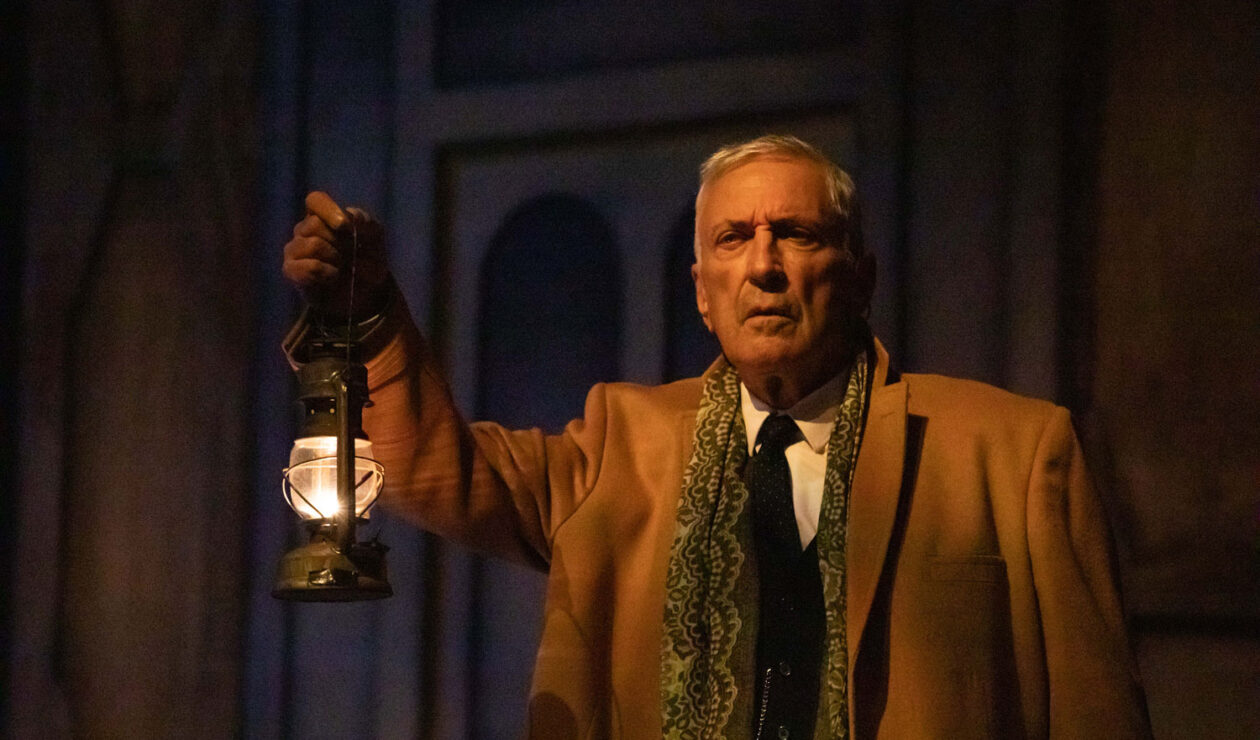This much-vaunted thriller, adapted for the stage by Stephen Mallatratt from Susan Hill’s 1983 novel of gothic horror, has just finished a 33-year stint in London, making it the second-longest run in the West End’s history, after Agatha Christie’s The Mousetrap.
Mallatratt’s cunning adaptation whittles the novel’s cast of characters down to two actors, and in this Australian production, the roles are more than admirably handled by home-grown icons John Waters and Daniel MacPherson.
The play opens on a simple set, which is swiftly revealed to be exactly as it seems – a theatre stage, empty except for a chair, a stool and wicker chest in front of an oddly-draped grey backdrop.
A nervous Arthur Kipps (Waters) is droning through a reading of a long manuscript he has penned himself. As a result of being drawn into a Christmas Eve telling of ghost stories, a frivolous family event of cheap thrills by candlelight, Kipps has realised he has a real tale of the supernatural to tell. But before he reveals all to his friends and family, he knows he needs help with the delivery.
To coach him on enlivening his reading, Kipps has hired a young, energetic actor (Daniel MacPherson) and soon the charismatic performer is adapting the story for the stage on the fly, stepping into the role of Arthur Kipps and embodying the older man as he was 30 years ago as an up-and-coming solicitor.
As the elder Kipp’s tale unfolds we see him as a young man sent to settle the estate of his legal firm’s client, Mrs Alice Drablow. He travels to the remote north-east of England, arriving at the fog-swathed manor of Eel Marsh House, an eerie place accessible only by a tidal causeway flanked by bogs of quicksand.
Kipp’s cheery, youthful confidence erodes as he finds himself not only isolated in the unnerving mansion but beset by supernatural visitations. Not even the company of the small (but invisible) dog Spider can alleviate his growing terror as he sorts through the papers left behind by the mysterious Alice Drablow. As the secrets of her life are brought to light, the sinister events in the house escalate.
The cleverest aspect of this play is its structure – a gothic ghost story nested within a framing narrative set 30 years later. In the retelling of Kipp’s tale of terror, the actors switch roles. Waters masterfully morphs from the nervous elder Kipps in the framing narrative to assuming the roles of all the secondary characters in the gothic storyline. Waters consolidates his reputation as an icon of Australian stage and screen with his effortless transitions and flawless range of northern accents.
MacPherson plays an excellent foil, his extremely animated portrayal of The Actor in the framing narrative contrasting perfectly with Waters bumbling elder Kipps. When slipping into the role of the younger Kipps, MacPherson maintains the engaging charisma of The Actor yet is still somehow a believable younger version of the man recounting his confrontation with the horror that transformed his life.
While touted as a one of the most terrifying pieces of theatre in West End history, much of the horror relies on dramatic devices that generate dread in the audience’s imagination. Upending the artistic maxim of ‘Show, don’t tell’, the audience is kept in the dark. Jump scares, creepy sound effects and a much-described but seldom seen (yet even so, unfairly uncredited) woman swathed in black all compound to manufacture an atmosphere of suspense that only hits its stride after the interval.
The absence of music and the bare set allow for the clever sound design by Rod Mead and Sebastian Frost to come to the fore. Sound effects such as horse hooves, railway noise, and the obligatory supernatural thuds and screams all work their atmospheric magic by insisting the audience rely on the magnifying effect of fearful imagination.

Get InReview in your inbox – free each Saturday. Local arts and culture – covered.
Thanks for signing up to the InReview newsletter.
The original lighting design by Kevin Sleep created the most interest, especially the scenes lit from behind the grey backdrop. This clever device produced gorgeously thick-shadowed vignettes, generating more gothic drama in the background than much of the action in front of the curtain.
Taking over Robin Herford’s directorial role for this Australian production, Antony Eden has delivered a faithful and well-acted version of this traditional and much-loved theatrical piece.
There’s been a renaissance in Australia of classic British theatre, as the success of recent productions of The Mousetrap and Gaslight attest. Audiences who flocked to those productions will undoubtedly revel in the time-honoured gothic chills delivered by The Woman in Black. This production is a suspenseful and wonderfully acted thriller, with just enough humour to lighten its gothic heft without spoiling the dark sting in the tail.
Touring production The Woman in Black (presented by PW Productions, Woodward Productions and Neil Gooding Productions) is playing at the Dunstan Playhouse until May 26.
Support local arts journalism
Your support will help us continue the important work of InReview in publishing free professional journalism that celebrates, interrogates and amplifies arts and culture in South Australia.
Donate Here




